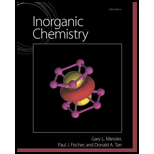
Concept explainers
L. C. Allen has suggested that a more meaningful formal charge can be obtained by taking into account theelectronegativities of the atoms involved Men’s formula for this type of charge—referred to as the Lewis—Langmuir
where
Want to see the full answer?
Check out a sample textbook solution
Chapter 3 Solutions
Inorganic Chemistry
- WRITE THE COMPLETE COMPUTATION of the FORMAL CHARGE of each atom using the formula: FC = V - N - B/2 a. Ethanol b. Chlorate ionarrow_forwardWrite a Lewis structure for the amide ion, NH2─, and assign formal charges to each atom.arrow_forwardP3- ion is a linear ion composed of 3 phosphorus atoms. Draw 3 resonance structures of this ion. Show the individual formal charges of all atoms. Indicate which structure is the best one.arrow_forward
- How many non-bonding electrons are on the central atom in the optimized Lewis structure of NBr3, in which the formal charges are minimized?arrow_forwardDetermine the number of valence electrons in SO₃ and then draw the corresponding Lewis structure (with minimized formal charges).arrow_forwardWhat is the formal charge of the oxygen atom in the carbon monoxide molecule? A. 0 B. +1 C. -1 D. +2 E. -2arrow_forward
- Determine the number of valence electrons in sulfuric acid (H₂SO₄) and then draw the corresponding Lewis structure (with minimized formal charges).arrow_forwardDraw three resonance structures for sulfur tetroxide, SO4,whose connections are shown below. (This is a neutral molecule; it is not a sulfate ion.) Assign formal charges to theatoms in each structure. Thanks!:)arrow_forward1-What is the formal charge of the nitrogen atom in hydrogen cyanide (HCN)? a.5 b.−1 c.0 d.1 e.2 2-Which of the following diatomic molecules has the least number of valence electrons? a.N2 b.F2 c.O2 d.Cl2 e.NOarrow_forward
 Chemistry: The Molecular ScienceChemistryISBN:9781285199047Author:John W. Moore, Conrad L. StanitskiPublisher:Cengage Learning
Chemistry: The Molecular ScienceChemistryISBN:9781285199047Author:John W. Moore, Conrad L. StanitskiPublisher:Cengage Learning Chemistry: Principles and ReactionsChemistryISBN:9781305079373Author:William L. Masterton, Cecile N. HurleyPublisher:Cengage Learning
Chemistry: Principles and ReactionsChemistryISBN:9781305079373Author:William L. Masterton, Cecile N. HurleyPublisher:Cengage Learning

